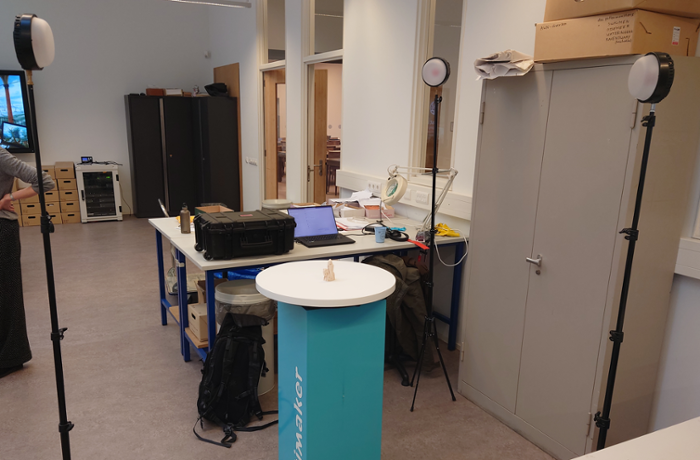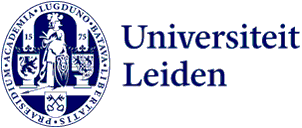
Archaeology brings 3D scanning into the classroom
In the course 'From Ceramics to Plastics: The Mediterranean in 12 objects' students were taught to work with 3D scanning technologies. One of the underlying reasons to introduce students to this technology was to teach them to reproduce objects. ‘More and more archaeological information is stored in digital or online environments.'
The Mediterranean in 12 objects
Archaeology students learn to work with 3D imaging during the BA2 seminar From Ceramics to Plastics: The Mediterranean in 12 objects. ‘The concept behind the course is to get students acquainted with the wider context of the material culture of the Mediterranean in the first millenium BC,’ Martina Revello Lami explains. ‘We are tackling broad themes, from identity to economy, mobility and sustainability, linking such themes to the present. In the classroom we teach the students to work with ancient (pottery) and modern (plastic) objects as if they were in a museum or on an excavation.’
New solutions
New in the course is the use of 3D imaging. Archaeology alumnus Max Montfrooij, now working at the Leiden Learning & Innovation Centre (LLInC), contacted Dr Revello Lami, noting that LLInC is investing in 3D technology. ‘Our main goal is to support teaching staff by adapting to new solutions,’ Montfrooij explains. ‘When I studied archaeology, I focused on the interaction with objects and sites. I wanted to bridge the gap between people and physical spaces in a novel and meaningful way.’ This led him to explore 3D technologies.
‘Previously, these applications were not available for students, but now there is a range of new solutions. Nowadays, infrared scanning is very sophisticated and affordable.’

LiDAR scanning
LLInC introduced Montfrooij to LiDAR scanning. ‘The technology is now integrated in the iPhone Pro. You can use the LiDAR scanning to measure distances between objects. This can lead to a 3D image file that might be used for augmented reality: projecting a digital and virtual object into actual space.’ All in all, it is an affordable and accessible way to create 3D models. ‘It occurred to me that this is a novel and easy way to start learning about 3D scanning. With this in mind I contacted Martina.’
This is how 3D scanning was integrated in the BA2 seminar. ‘Max joined the class and started to teach students how to work with an iPhone as a 3D scanner,’ Revello Lami states. 'We both had experience with other 3D devices, but we were absolute beginners with the iPhone! So we learned together with the students. We basically threw them (and ourselves) in the trench: here's an iPhone, go ahead!’

Awareness
One of the underlying reasons to introduce students to this technology was to teach them to reproduce objects. ‘More and more archaeological information is stored in digital or online environments,’ Montfrooij explains. ‘It is an easy mistake to think that 3D models portray an object as it is in reality. This is not necessarily the case. There are several factors involved in the creation of a 3D model, from lighting choices, to exposure and environmental conditions that you need to take into account. The idea was to make students aware of that. Teach them to be critical when creating and investigating these models.’
This was gratefully received by the students. 'The use of 3D technologies within the course made it even more intriguing and interesting,' bachelor's student Annalisa Bardini notes. 'It allowed me to learn new skills that will be very useful in the future. Combining the study of ceramics with new technologies such as the 3D scanner made the course very original and engaging.'
Developing the workflow
Revello Lami let the students develop the full workflow involved in creating 3D models. ‘They got acquainted with the acquisition process very quickly. Afterwards they had to share all models with the whole class, and work through the post processing. Documentation of archaeological objects is already an interpretation, and authenticity with 3D models becomes even more ethically problematic, when considering all factors that can impact the acquisition process.’ The process is far less straightforward and direct than you would think.
Student Roos Molenkamp liked the addition of 3D scanning to the course material. 'It was a really fun surprise to learn that we would use LiDAR for the documentation. Even though some of the artifact were a bit difficult to scan correctly, the overall process was easy to the hang of and explained very well. The experience made me confident about (the basics) of 3D modelling.'

Virtual exhibition
The end product of the seminar was a virtual exhibition featuring 3D scanned objects, telling a very material story of the Mediterranean. ‘Aside from being a great exercise to reflect on digitalisation, it was a reflection on 3D data and asset management. The whole seminar recreated in a microcosm the traditional archaeological process, from acquisition to interpretation and display: documenting an object, understanding it, making it available, and creating a space in which the object is narrated.’
'Learning how to build a virtual exhibit was certainly challenging but very stimulating, it allowed us to try a different approach from the classical one we had seen so far.' Annalisa adds. 'I believe both the 3D scanner and the use of virtual exhibits are methods I will reuse in the future, as I really enjoyed combining the study of ancient objects and finds with modern technologies and software.'
The online exhibitions can be visited! Check out Containers Through Time: A Journey in Personal Care and Flowing Trajectories.
Connecting themes
Next to developing skills in 3D scanning and processing, the seminar had the goal to connect relevant themes in the past as well as in the present. ‘We focus on major issues that play an important role in modern day society, like plastic waste and pollution,’ Revello Lami concludes. ‘Some of the students have been in contact with the RESPIRE project in which modern day plastics abandoned on the Mediterranean shores are investigated by applying a truly archaeological method. One of them actually joined the project annual fieldwork in Lampedusa. We are called to use all our archaeological skills in the future to tackle not just the past but the present, you cannot shy away from this responsibility.’
